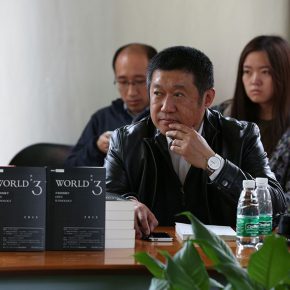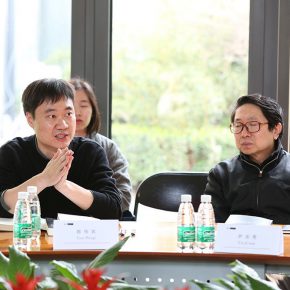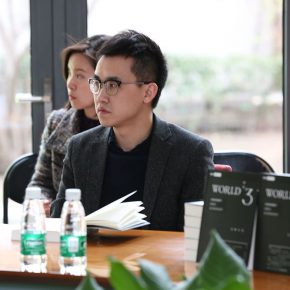
OCAT Institute organizes and edits the annual Chinese academic publication of art history entitled the “World 3”, which is a set of books that in each issue aims to explore the theoretical concepts and methods in art history, around a specific academic theme, mainly publishing cutting-edge research topics and translations of art history and the related history of language, history of psychology, history of philosophy, history of culture, history of religion, history of society and history of ideology. “World 3” journal issue 1 was themed on “Art History as the Concept”, while issue 2 “Open Iconology” was officially published recently.
Modern iconology has become an open disciplinary approach through the efforts of the three art historians including Warburg, Pannovsky and Gombrich, and it is one of the most popular research methods for art historians. The Warburg School, through the building of the interpretation of images on the basis of the broad dimension of culture and science to lay the foundation for the history of art as a human study. Pannovsky was through his in-depth and broad historical conception, strict and wise realm of knowledge, developed the iconology which obtained an outstanding achievement similar to other humanities; Gombrich hoped that the critical studies on the iconology would bring it into a more fascinating open realm. To this day, iconology has been an eminent study that is still worth exploring, on the one hand, there are many unknown things of iconology in the traditional sense; on the other hand, the concept of iconology and the problem of the observation are also in a changing state, while the changes of time, geography, culture, context and other factors have led to presentations of different faces. Based on this, the “World 3” journal issue 2 selects “Open Iconology” as the theme.
On March 25, 2017, the book launch of the “World 3: Open Iconology” was held in the OCAT institute in Beijing, Prof. Yin Ji'nan from Central Academy of Fine Arts and the editorial board member of the books, Yin Dejian, a publisher and Director of the China National Photography Press, Fan Baiding, a teacher from China Academy of Art and an editor of the books, Guo Weiqi, a teacher from Guangzhou Academy of Fine Arts and an editor of the books, attended the book launch and communicated with the readers on the related topics of iconology, cutting-edge studies, as well as the framework of the series, and the follow-up publishing program.
Prof. Yin Ji'nan recalled the background and the specific situation when he participated in the “World 3” at that time, and also offered a retrospective of the process of writing and research on the history of art in China, the research and writing of “World 3” was unfolded on three levels: historical research itself; the writing of history; on the discussion of methodological issues, this triple interaction might be able to push the research in the history of art forward to a new process. The Editor of the “World 3: Open Iconology” Fan Baiding talked about the reasons for talking about iconology, Pannovsky separated iconology into three stages: pre-iconography, iconography and iconology, what was solved by the third stage is blurry, and Pannowski did not clearly express this in the “Study on Iconology” yet, it brought up again now that both are restoring the open features of “iconology”, and the re-understanding of the history of art.
“World 3” is an academic journal presented by the OCAT Institute, the editor Guo Weiqi also introduced the publishing plan of issue 3, which is initially identified as “Studies on Overseas Chinese History of Art Over Three Decades”. Prof. Hong Zaixing published the “Anthology of the Studies on Overseas Chinese Paintings” in the early years, where the ways used by Western scholars studying the Chinese history of art are summarized as “outward” and “inward”. Time has changed, what is the situation Westerners studying Chinese history of art, after all, the boundary of the term of “overseas” has been blurred, and the book will observe the international dynamics which had a relationship with the studies on Chinese art in the past three decades. “World 3” series 3 is scheduled to be published in early next year. In addition, issue 4 themed the “History of Art and Museum”, is currently soliciting contributions.
Text by Zhang Wenzhi, translated by Chen Peihua and edited by Sue/CAFA ART INFO
Photo by the organizer
Attachment: “World 3: Open Iconology” Directory
Huang Zhuan, Foreword
Fan Baiding, Editor’s preamble
Special StudiesPail Oskar Kristeller (U.S.), “Rhetoric in Medieval and Renaissance Culture”
Yang Siliang, Exploration on the Origin of “Personification”
Philippe-Alain Michaud (France), “Mnemosyne Atlas”, art history and the composition of the scene
Uwe Fleckner (Germany), Independence of Words – Pictorial Comparative Study between Aby Warburg and the Art Publishing Experiment
Fan Baiding, Some theoretical sources of the “Iconology Study”
Qian Wenyi, “Let the picture have its word: Foucault and the Metapicture in the 1990s”
Yi Donghua, “Picture” and “Image” in the Chinese Classical Context
Theoretical Focuses
Georges Didi-Huberman (France), Return Sensibility
By the Gentle Gait of the Maiden (pictorial knowledge, centrifugal knowledge)
Movies, essays and poems – Pier Paolo Pasolini’s “Anger”
Zou Jianlin, Foundation of the Technology, Memory and Image – A Comparative Study on Frussel, Stigler and Belting
Frontier DynamicsHuang Jianhong (Taiwan), People under the Montage – Sidelights of the 2015 OCAT Institute Annual Lectures and the Related Activities
Institutional OverviewThomas DaCosta Kaufmann, Words of Lilliput? – Retrospection on the Warburg Institute in London in the early 1970s
Book ReviewsFan Jingzhong, Preface to the “Translations of the History of Art”
Lee B. Brown (U.S.) reviews W. J. T. Mitchell’s “Iconology Image, Text, Ideology”

































